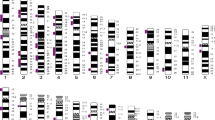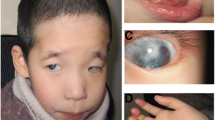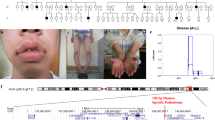Abstract
The molecular basis of Mayer-Rokitansky-Kuster-Hauser (MRKH) syndrome remains largely unknown. Pathogenic variants in WNT4 and HNF1B have been confirmed in a small percent of individuals. A variety of copy number variants have been reported, but causal gene(s) remain to be identified. We hypothesized that rare structural variants (SVs) would be present in some individuals with MRKH, which could explain the genetic basis of the syndrome. Large molecular weight DNA was extracted from lymphoblastoid cells from 87 individuals with MRKH and available parents. Optical genome mapping (OGM) was performed to identify SVs, which were confirmed by another method (quantitative PCR, chromosomal microarray, karyotype, or fluorescent in situ hybridization) when possible. Thirty-four SVs that overlapped coding regions of genes with potential involvement in MRKH were identified, 14 of which were confirmed by a second method. These 14 SVs were present in 17/87 (19.5%) of probands with MRKH and included seven deletions, three duplications, one new translocation in 5/50 cells—t(7;14)(q32;q32), confirmation of a previously identified translocation—t(3;16)(p22.3;p13.3), and two aneuploidies. Of interest, three cases of mosaicism (3.4% of probands) were identified—25% mosaicism for trisomy 12, 45,X(75%)/46,XX (25%), and 10% mosaicism for a 7;14 translocation. Our study constitutes the first systematic investigation of SVs by OGM in individuals with MRKH. We propose that OGM is a promising method that enables a comprehensive investigation of a variety of SVs in a single assay including cryptic translocations and mosaic aneuploidies. These observations suggest that mosaicism could play a role in the genesis of MRKH.


Similar content being viewed by others
Data availability
The datasets generated during and analyzed during the current study are available from the corresponding author on reasonable request.
References
Acien P, Acien M, Sanchez-Ferrer M (2004) Complex malformations of the female genital tract. New types and revision of classification. Hum Reprod 19(10):2377–2384. https://doi.org/10.1093/humrep/deh423deh423. (In Eng)
Akbari A, Padidar K, Salehi N et al (2021) Rare missense variant in MSH4 associated with primary gonadal failure in both 46, XX and 46 XY individuals. Hum Reprod 36(4):1134–1145. https://doi.org/10.1093/humrep/deaa362
Bean EJ, Mazur T, Robinson AD (2009) Mayer-Rokitansky-Kuster-Hauser syndrome: sexuality, psychological effects, and quality of life. J Pediatr Adolesc Gynecol 22(6):339–346. https://doi.org/10.1016/j.jpag.2008.11.006
Biason-Lauber A, De Filippo G, Konrad D, Scarano G, Nazzaro A, Schoenle EJ (2007) WNT4 deficiency–a clinical phenotype distinct from the classic Mayer-Rokitansky-Kuster-Hauser syndrome: a case report. Hum Reprod 22(1):224–229. https://doi.org/10.1093/humrep/del360. (In Eng)
Biason-Lauber A, Konrad D, Meyer M, DeBeaufort C, Schoenle EJ (2009) Ovaries and female phenotype in a girl with 46, XY karyotype and mutations in the CBX2 gene. Am J Hum Genet 84(5):658–663. https://doi.org/10.1016/j.ajhg.2009.03.016. (In Eng)
Biason-Lauber A, Konrad D, Navratil F, Schoenle EJ (2004) A WNT4 mutation associated with Mullerian-duct regression and virilization in a 46, XX woman. N Engl J Med. 351(8):792–8. (In eng) (http://www.ncbi.nlm.nih.gov/entrez/query.fcgi?cmd=Retrieve&db=PubMed&dopt=Citation&list_uids=15317892). Accessed 13 Aug 2010
Boulard S, Diene G, Barat R, et al. (2006) A case of trisomy 12 mosaicism with pituitary malformation and polycystic ovary syndrome. Genet Couns. 17(2):173–83. (https://www.ncbi.nlm.nih.gov/pubmed/16970035). Accessed 5 Sept 2022
Ceroni F, Simpson NH, Francks C et al (2014) Homozygous microdeletion of exon 5 in ZNF277 in a girl with specific language impairment. Eur J Hum Genet 22(10):1165–1171. https://doi.org/10.1038/ejhg.2014.4
Chen MJ, Wei SY, Yang WS et al (2015) Concurrent exome-targeted next-generation sequencing and single nucleotide polymorphism array to identify the causative genetic aberrations of isolated Mayer-Rokitansky-Kuster-Hauser syndrome. Hum Reprod 30(7):1732–1742. https://doi.org/10.1093/humrep/dev095
Cheroki C, Krepischi-Santos AC, Szuhai K et al (2008) Genomic imbalances associated with mullerian aplasia. J Med Genet 45(4):228–232. https://doi.org/10.1136/jmg.2007.051839. (In Eng)
Cui C, Shu W, Li P (2016) Fluorescence in situ hybridization: cell-based genetic diagnostic and research applications. Front Cell Dev Biol 4:89. https://doi.org/10.3389/fcell.2016.00089
Dode C, Levilliers J, Dupont JM, et al. (2003) Loss-of-function mutations in FGFR1 cause autosomal dominant Kallmann syndrome. Nat Genet. 33(4):463–5. (http://www.ncbi.nlm.nih.gov/entrez/query.fcgi?cmd=Retrieve&db=PubMed&dopt=Citation&list_uids=12627230). Accessed 13 Aug 2010
Ebert P, Audano PA, Zhu Q et al (2021) Haplotype-resolved diverse human genomes and integrated analysis of structural variation. Science. https://doi.org/10.1126/science.abf7117
Hainz D, Kruger M, Reber D et al (2021) Mosaic trisomy 12 diagnosed in a female patient: clinical features, genetic analysis, and review of the literature. World J Pediatr 17(4):438–448. https://doi.org/10.1007/s12519-021-00438-9
Herlin M, Hojland AT, Petersen MB (2014) Familial occurrence of Mayer-Rokitansky-Kuster-Hauser syndrome: a case report and review of the literature. Am J Med Genet A 164A(9):2276–2286. https://doi.org/10.1002/ajmg.a.36652
Huang CC, Orvis GD, Kwan KM, Behringer RR (2014) Lhx1 is required in Mullerian duct epithelium for uterine development. Dev Biol 389(2):124–136. https://doi.org/10.1016/j.ydbio.2014.01.025
Jafri M, Wake NC, Ascher DB et al (2015) Germline Mutations in the CDKN2B tumor suppressor gene predispose to renal cell carcinoma. Cancer Discov 5(7):723–729. https://doi.org/10.1158/2159-8290.CD-14-1096
Jeffet J, Margalit S, Michaeli Y, Ebenstein Y (2021) Single-molecule optical genome mapping in nanochannels: multidisciplinarity at the nanoscale. Essays Biochem 65(1):51–66. https://doi.org/10.1042/EBC20200021
Kim HG, Herrick SR, Lemyre E, et al. (2005) Hypogonadotropic hypogonadism and cleft lip and palate caused by a balanced translocation producing haploinsufficiency for FGFR1. J Med Genet 42(8):666–72. (http://www.ncbi.nlm.nih.gov/entrez/query.fcgi?cmd=Retrieve&db=PubMed&dopt=Citation&list_uids=16061567). Accessed 13 Aug 2010
Layman LC (2014) The genetics of mullerian aplasia. Expert Rev Endocrinol Metab 9:411–419
Layman LC, Porto AL, Xie J, et al. (2002) FSH beta gene mutations in a female with partial breast development and a male sibling with normal puberty and azoospermia. J Clin Endocrinol Metab. 87(8):3702–7. (http://www.ncbi.nlm.nih.gov/entrez/query.fcgi?cmd=Retrieve&db=PubMed&dopt=Citation&list_uids=12161499). Accessed 13 Aug 2010
Ledig S, Schippert C, Strick R, Beckmann MW, Oppelt PG, Wieacker P (2011) Recurrent aberrations identified by array-CGH in patients with Mayer-Rokitansky-Kuster-Hauser syndrome. Fertil Steril 95(5):1589–1594. https://doi.org/10.1016/j.fertnstert.2010.07.1062
Ledig S, Tewes AC, Hucke J et al (2018) Array-comparative genomic hybridization analysis in patients with Mullerian fusion anomalies. Clin Genet 93(3):640–646. https://doi.org/10.1111/cge.13160
Levy-Sakin M, Ebenstein Y (2013) Beyond sequencing: optical mapping of DNA in the age of nanotechnology and nanoscopy. Curr Opin Biotechnol 24(4):690–698. https://doi.org/10.1016/j.copbio.2013.01.009
Lindner TH, Njolstad PR, Horikawa Y, Bostad L, Bell GI, Sovik O (1999) A novel syndrome of diabetes mellitus, renal dysfunction and genital malformation associated with a partial deletion of the pseudo-POU domain of hepatocyte nuclear factor-1beta. Hum Mol Genet 8(11):2001–2008 ((In eng))
Louden ED, Poch A, Kim HG, Ben-Mahmoud A, Kim SH, Layman LC (2021) Genetics of hypogonadotropic Hypogonadism-Human and mouse genes, inheritance, oligogenicity, and genetic counseling. Mol Cell Endocrinol 534:111334. https://doi.org/10.1016/j.mce.2021.111334
Ma J, Qin Y, Liu W, Duan H, Xia M, Chen ZJ (2011) Analysis of PBX1 mutations in 192 Chinese women with Mullerian duct abnormalities. Fertil Steril 95(8):2615–2617. https://doi.org/10.1016/j.fertnstert.2011.04.074
Meena A, Daga MK, Dixit R (2016) Unusual association of Turner syndrome and Mayer-Rokitansky-Kuster-Hauser syndrome. BMJ Case Rep. https://doi.org/10.1136/bcr-2015-212634
Mikhael S, Dugar S, Morton M et al (2021) Genetics of agenesis/hypoplasia of the uterus and vagina: narrowing down the number of candidate genes for Mayer-Rokitansky-Kuster-Hauser Syndrome. Hum Genet 140(4):667–680. https://doi.org/10.1007/s00439-020-02239-y
Muller V, Westerlund F (2017) Optical DNA mapping in nanofluidic devices: principles and applications. Lab Chip 17(4):579–590. https://doi.org/10.1039/c6lc01439a
Nik-Zainal S, Strick R, Storer M et al (2011) High incidence of recurrent copy number variants in patients with isolated and syndromic Mullerian aplasia. J Med Genet 48(3):197–204. https://doi.org/10.1136/jmg.2010.082412. (In Eng)
Nurk S, Koren S, Rhie A et al (2022) The complete sequence of a human genome. Science 376(6588):44–53. https://doi.org/10.1126/science.abj6987
Oppelt PG, Lermann J, Strick R et al (2012) Malformations in a cohort of 284 women with Mayer-Rokitansky-Kuster-Hauser syndrome (MRKH). Reprod Biol Endocrinol 10:57. https://doi.org/10.1186/1477-7827-10-57
Sahajpal NS, Barseghyan H, Kolhe R, Hastie A, Chaubey A (2021) Optical genome mapping as a next-generation cytogenomic tool for detection of structural and copy number variations for prenatal genomic analyses. Genes. https://doi.org/10.3390/genes12030398
Sahajpal NS, Mondal AK, Ananth S et al (2022a) Optical genome mapping and single nucleotide polymorphism microarray: an integrated approach for investigating products of conception. Genes. https://doi.org/10.3390/genes13040643
Sahajpal NS, Mondal AK, Tvrdik T et al (2022b) Clinical validation and diagnostic utility of optical genome mapping for enhanced cytogenomic analysis of hematological neoplasms. J Mol Diagn. https://doi.org/10.1016/j.jmoldx.2022.09.009
Sahajpal NS, Jill Lai CY, Hastie A et al (2022c) Optical genome mapping identifies rare structural variations as predisposition factors associated with severe COVID-19. iScience 25(2):103760. https://doi.org/10.1016/j.isci.2022.103760
Uddin M, Thiruvahindrapuram B, Walker S et al (2015) A high-resolution copy-number variation resource for clinical and population genetics. Genet Med 17(9):747–752. https://doi.org/10.1038/gim.2014.178
Volleth M, Zenker M, Joksic I, Liehr T (2020) Long-term culture of EBV-induced human lymphoblastoid cell lines reveals chromosomal instability. J Histochem Cytochem 68(4):239–251. https://doi.org/10.1369/0022155420910113
Williams LS, Kim HG, Kalscheuer VM et al (2016) A balanced chromosomal translocation involving chromosomes 3 and 16 in a patient with Mayer-Rokitansky-Kuster-Hauser syndrome reveals new candidate genes at 3p22.3 and 16p13.3. Mol Cytogenet 9:57. https://doi.org/10.1186/s13039-016-0264-6
Williams LS, DemirEksi D, Shen Y et al (2017) Genetic analysis of Mayer-Rokitansky-Kuster-Hauser syndrome in a large cohort of families. Fertil Steril 108(1):145-151 e2. https://doi.org/10.1016/j.fertnstert.2017.05.017
Zhong Q, Layman LC (2012) Genetic considerations in the patient with turner syndrome–45, X with or without mosaicism. Fertil Steril 98(4):775–779. https://doi.org/10.1016/j.fertnstert.2012.08.021. (In Eng)
Acknowledgements
We would like to acknowledge Dr. James Knight at the Yale Center for Genome Analysis Bioinformatics Core.
Funding
This work was funded by Combined Intramural Grant Program at MCG/AU (S. Brakta) and NICHD 1R01 HD092505 (L.C. Layman).
Author information
Authors and Affiliations
Contributions
All authors contributed to this manuscript. The study was funded by SB and LL. Samples were collected and lymphoblastoid cells were grown for DNA extraction by ZH and LC. Optical genome mapping was performed by NS and RK. Confirmation of selected variants and analysis of data was performed by SB, ZH, NS, DK, H-GK, LC, JP, RK, LL. Statistical analysis was performed by HX. The manuscript was written by SB and LL, but all authors read and approved the final manuscript.
Corresponding authors
Ethics declarations
Conflict of interest
Ravindra Kolhe has received honoraria, and/or travel funding, and/or research support from Illumina, Asuragen, QIAGEN, Perkin Elmer Inc, Bionano Genomics, Agena, Agendia, PGDx, Thermo Fisher Scientific, Cepheid, and BMS. Nikhil Sahajpal owns limited number of personal stocks of Bionano Genomics Inc. However, no members of Bionano were involved in this study. The rest of the authors have no relevant financial or non-financial interests to disclose.
Ethical approval
This study was approved by the IRB at the Medical College of Georgia at Augusta University.
Consent to participate
Informed consent was obtained from all individual participants included in the study.
Consent to publish
This is not applicable as no personal data were included in the manuscript.
Additional information
Publisher's Note
Springer Nature remains neutral with regard to jurisdictional claims in published maps and institutional affiliations.
Supplementary Information
Below is the link to the electronic supplementary material.
Rights and permissions
Springer Nature or its licensor (e.g. a society or other partner) holds exclusive rights to this article under a publishing agreement with the author(s) or other rightsholder(s); author self-archiving of the accepted manuscript version of this article is solely governed by the terms of such publishing agreement and applicable law.
About this article
Cite this article
Brakta, S., Hawkins, Z.A., Sahajpal, N. et al. Rare structural variants, aneuploidies, and mosaicism in individuals with Mullerian aplasia detected by optical genome mapping. Hum Genet 142, 483–494 (2023). https://doi.org/10.1007/s00439-023-02522-8
Received:
Accepted:
Published:
Issue Date:
DOI: https://doi.org/10.1007/s00439-023-02522-8




